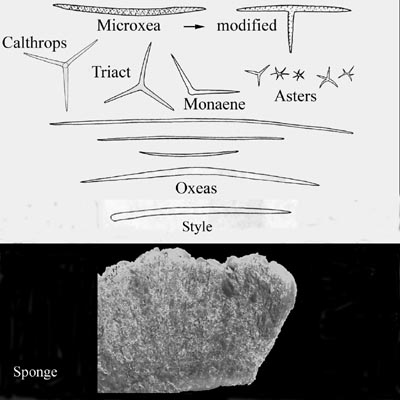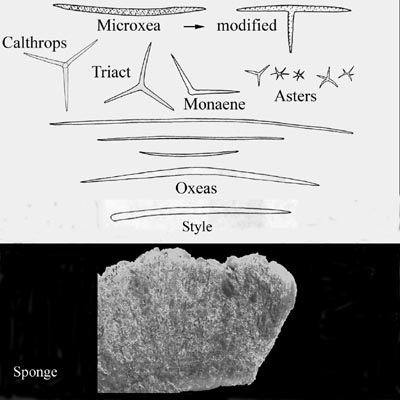[A]
Microxeas: 86 -129- 350 μm.
Calthrops 450 - 650 μm. |
 Sollas, 1886
Sollas, 1886 |
Sponge:
Lamellar. One side with pores 0.2 mm, superficially smooth. Other side with scattered oscula - 0.3-0.4 mm diameter and thin Oxeas penetrating surface.
Consistency: firm.
Surface: rough and prickly.
Color: Alive: Drab.
Spicules: Megascleres:
(1) Calthrops:
Rays: 260 - 433-700 um.
x 21 -36- 62 um.
(2) Oxeas (long and thin):
1550 -2052- 2525 um.
x 8 -16- 26 um.
(3) Oxeas (short and thick):
530 -705- 1100 um.
13 -20- 31 um.
(4) Oxeas (long and thick):
1475 -2207- 2750 um.
x 29 -47- 78 um.
(5) Styles:
675 -1796- 2500 um.
x 39 -53- 72 um.
Microscleres:
(1) Asters:
10 -23- 34 um.
* (2) Pleisiasters-Metasters:
22 um.
** (3) Microxeas:
86 -129- 151 um.
Skeleton:
Ectosome: Fragile dermal membrane with abundant asters.
Choanosome: Confused, with Calthrops and Oxeas.
Distribution: Central California.
Depth: Deep water.
Note: *Measurements of Green & Bakus, 1994. * *Reported to have Pleisiasters transitional to metasters 22 μm. This has been synonymized with P. rickettsi. See below.
|
|
[B]
Notes on the synonymy of P. rickettsi from California with P. tenuilaminaris.
|

| | Poecillastra rickettsi
de Laubenfels, 1930 = Poecillastra tenuilaminaris Sollas, 1886 |
Spicules: Megascleres:
see note.
Specimens of Poecillastra rickettsi de Laubenfels, 1930 from California have been synonymized with Poecillastra tenuilaminaris (Sollas 1888) by Hooper & Van Soest, 2002 pg. 154.
The type of P. rickettsi deLaubenfels, 1930 was found to be contaminated with Vulcanella spicules.
The identification of this and related species is made difficult as a result of the exceedingly long megascleres which break easily, and deep water collection which often brings up fragments. Green & Bakus, 1994 report both long and short Oxeas. Others use a single range of spicule length and width.
|
|